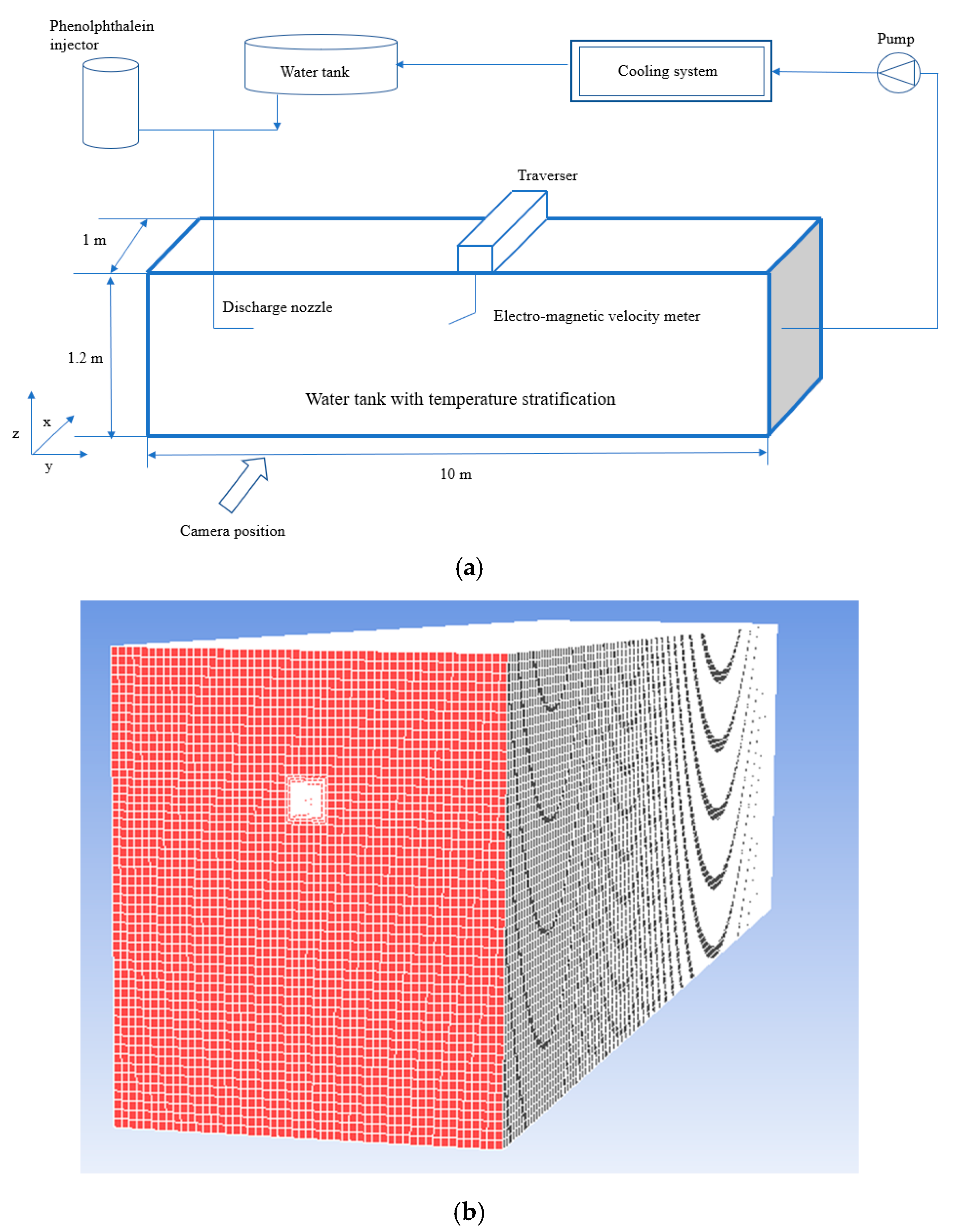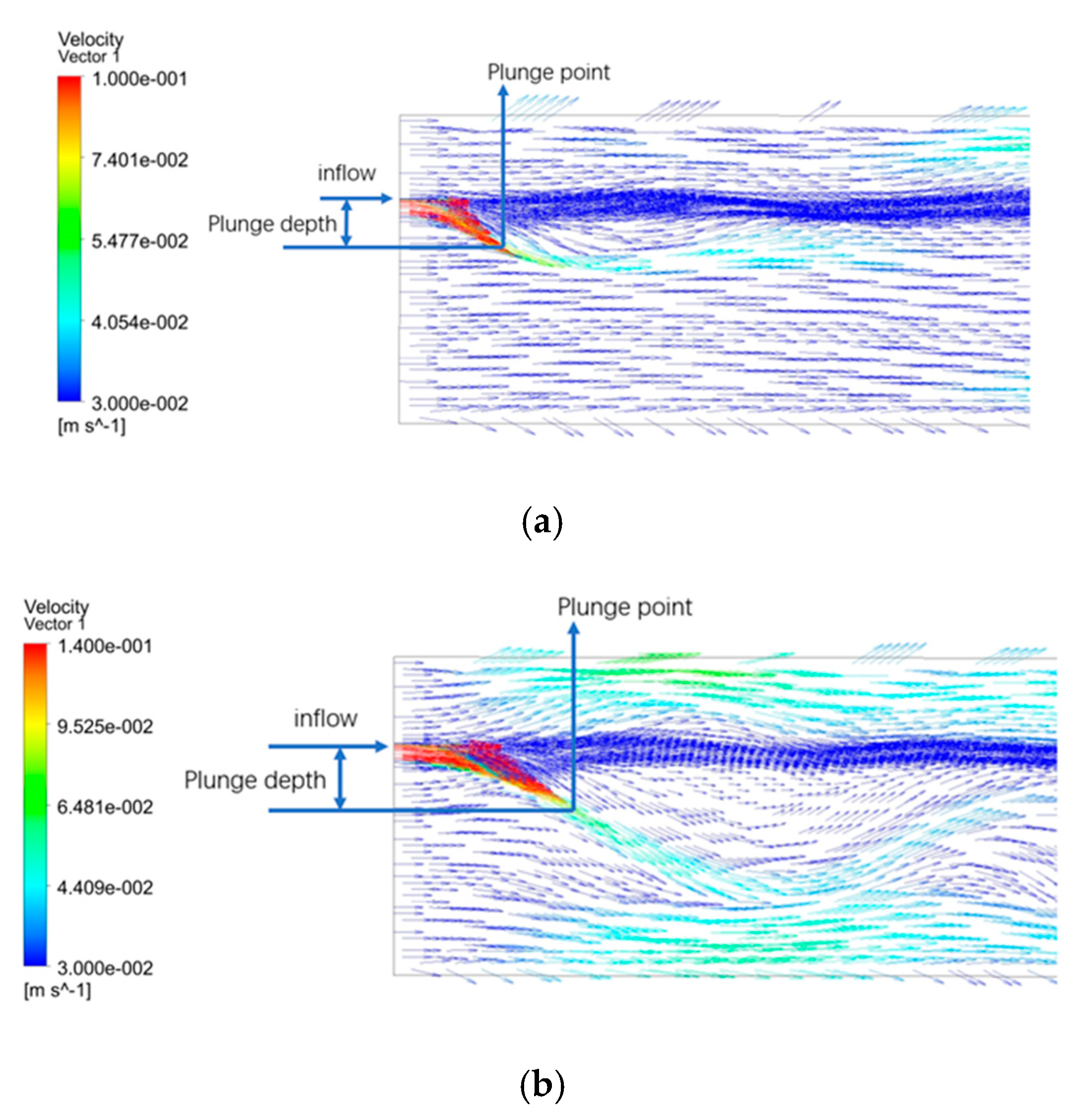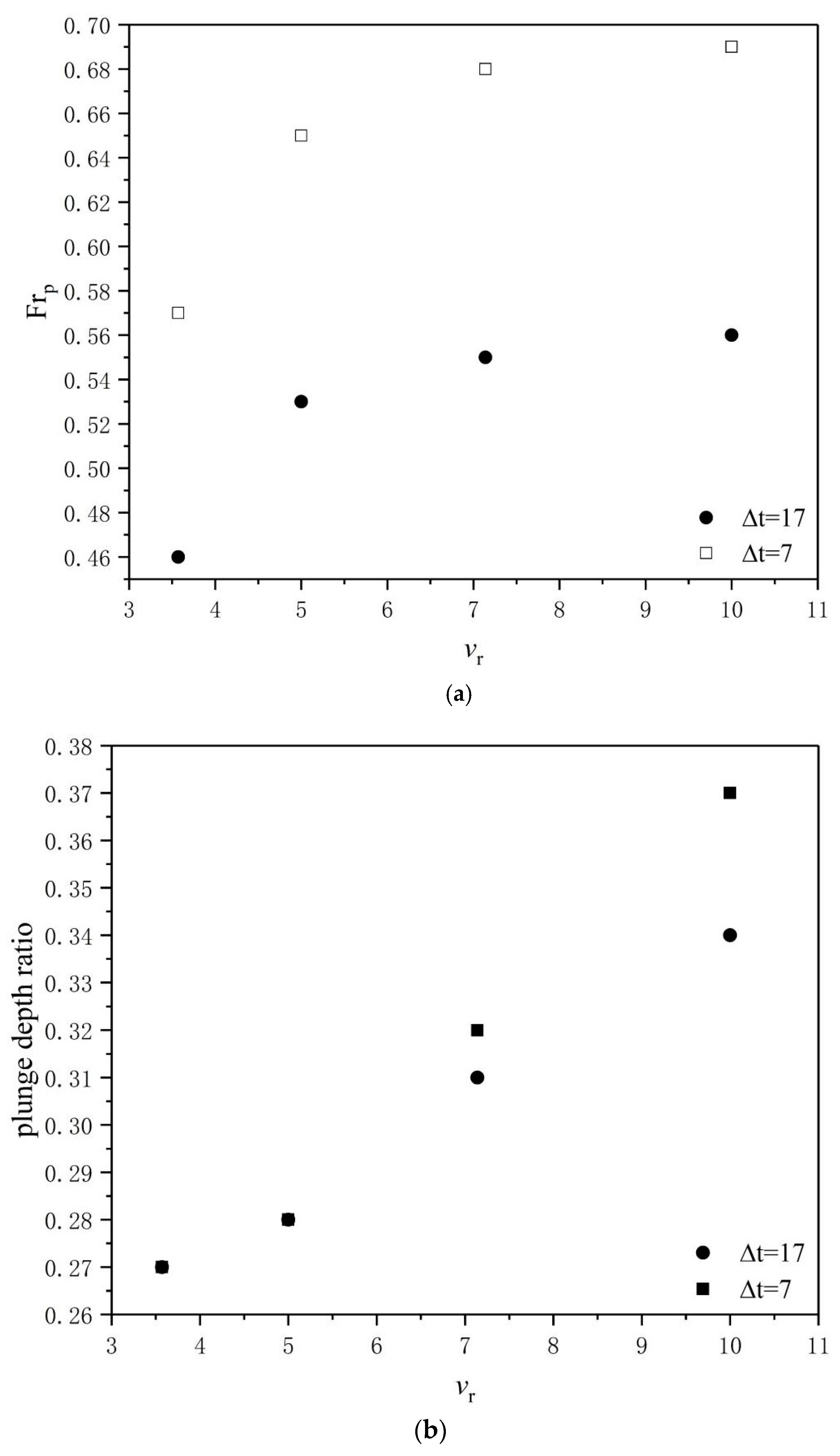A Numerical Investigation of the Plunging Phenomenon of Cold Water Discharged from Ocean Thermal Energy Conversion Systems
Abstract
:1. Introduction
2. Equations Used in the Models and Numerical Process
2.1. N-S equations, Energy Equation, Turbulence Model Equations
2.2. Boundary Condition
2.3. Model Description and Numerical Process
3. Analysis of Results
3.1. Cool Water Discharge
3.2. Plunging Phenomenon
4. Conclusions
Author Contributions
Funding
Acknowledgments
Conflicts of Interest
References
- Bando, A.; Sakurazawa, S.; Umeki, M.; Ikegami, Y. Ocean Nutrient Enhancer “TAKUMI” for the experiment of Fishing Ground Creation. In Proceedings of the 3th IOES Symposium, Tsukuba, Japan, 5–19 September 2004; pp. 5–6. [Google Scholar]
- Ouchi, K.; Otsuka, K.; Omura, H. Recent advances of ocean nutrient enhancer “TAKUMI” project. In Proceedings of the sixth ISOPE Ocean Mining Symposium, Changsha, Hunan, China, 9–13 September 2005; pp. 9–13. [Google Scholar]
- Grandelli, P.; Rocheleau, G.; Hamrick, J.; Church, M.; Powell, B. Modeling the Physical and Biochemical Influence of Ocean Thermal Energy Conversion Plant Discharges into Their Adjacent Waters; U.S. Department of Energy Award NO. DE-EE0003638; Makai Ocean Engineering, Inc.: Kailua, HI, USA, 29 September 2012. [Google Scholar]
- Akiyama, J.; Stefan, G.H. Plunging flow into a reservoir: Theory. J. Hydraul. Eng. 1984, 110, 484–499. [Google Scholar] [CrossRef]
- Sequeiros, O.E. Estimating current turbidity conditions from channel morphology: A Froude number approach. J. Geophys. Res. Ocean. 2012, 117. [Google Scholar] [CrossRef]
- Alavian, V. Behavior of density current on an incline. J. Hydraul. Eng. 1986, 112, 27–42. [Google Scholar] [CrossRef]
- Alavian, V.; Jirka, G.H.; Denton, R.A.; Johnson, M.C.; Stefan, H.G. Density Currents Entering Lakes and Reservoirs. J. Hydraul. Eng. 1992, 118, 1464–1489. [Google Scholar] [CrossRef]
- Dallimore, C.J.; Imberger, J.; Hodges, B.R. Modeling a plunging underflow. J. Hydraul. Eng. 2004, 130, 1068–1076. [Google Scholar] [CrossRef] [Green Version]
- Poudeh, H.T.; Emamgholizadeh, S.; Fathi-Moghadam, M. Experimental study of the velocity of density currents in convergent and divergent channels. Int. J. Sediment Res. 2014, 29, 518–523. [Google Scholar] [CrossRef]
- Farrell, G.J.; Stefan, H.G. Mathematical modeling of plunging reservoir flows. J. Hydraul. Res. 1988, 26, 525–537. [Google Scholar] [CrossRef]
- Rodi, W. Example of calculation methods for flow and mixing in stratified fluids. J. Geophys. Res. 1987, 92, 5305–5328. [Google Scholar] [CrossRef]
- Kassem, A.; Imran, J.; Khan, J.A. Three-dimensional modeling of negatively buoyant flow in diverging channels. J. Hydraul. Eng. 2003, 129, 936–947. [Google Scholar] [CrossRef]
- Fukushima, Y.; Watanabe, M. Numerical simulation of density underflow by the k-ε turbulence model. J. Hydrosci. Hydr. Engrg. 1990, 8, 31–40. [Google Scholar] [CrossRef] [Green Version]
- Ji, C.; Munjiza, A.; Avital, E.; Ma, J.; Williams, J. Direct numerical simulation of sediment entrainment in turbulent channel flow. Phys. Fluids 2013, 25, 056601. [Google Scholar] [CrossRef]
- MacIntyre, S.; Sickman, J.; Goldthwait, S.; Kling, G. Physical pathways of nutrient supply in a small, ultraoligotrophic arctic lake during summer stratification. Limnol. Oceanogr. 2006, 51, 1107–1124. [Google Scholar] [CrossRef] [Green Version]
- Hughes, G.O.; Griffiths, R.W. A simple convective model of the global overturning circulation, including effects of entrainment into sinking regions. Ocean Modell. 2006, 12, 46–79. [Google Scholar] [CrossRef]
- Fuji, T.; Ikegami, Y.; Cai, W.X.; Monde, M. A Numerical Analysis of a Two-Dimensional Cool Water Jet into an Open Water Channel with Temperature Stratification. Bull. Soc. Sea Water Sci. Jpn. 2004, 58, 93–101. (In Japanese) [Google Scholar]
- Sakurazawa, S.; Ikegami, Y.; Bando, A.; Umeki, M.; Monde, M. Influence of Thermal Stratification on the Penetration Depth of Cool Water Jet. Bull. Soc. Sea Water Sci. Jpn. 2005, 59, 292–300. (In Japanese) [Google Scholar]
- Noto, K.; Matsushita, Y. Formulations and Direct Numerical Simulation Methods for Effects of Coriolis Forces, Latitude, and Stability Stratified Ambient on a Large-Scale Thermal Plume. Numer. Heat Transf. A 2007, 51, 363–392. [Google Scholar] [CrossRef]
- Tatsumoto, H.; Park, J.; Machida, M.; Aikawa, M. Study on Behavior of Density Current in a Small Reservoir. J. Jpn. Soc. Hydrol. Water Resour. 2004, 17, 3–12. [Google Scholar] [CrossRef] [Green Version]
- Singh, B.; Shah, C.R. Plunging phenomenon of density currents in reservoirs. La Houille Blanche 1971, 26, 59–64. [Google Scholar] [CrossRef] [Green Version]





| Velocity of Discharge Water (v2) (m/s) | Velocity of Ambient Water (v1) (m/s) | Temperature Difference(ΔT) (k) | Height of Discharge Inlet (h) (m) |
|---|---|---|---|
| 0.05, 0.1, 0.14, 0.2, 0.28 | 0.02 | 7, 17 | 0.9 |
© 2020 by the authors. Licensee MDPI, Basel, Switzerland. This article is an open access article distributed under the terms and conditions of the Creative Commons Attribution (CC BY) license (http://creativecommons.org/licenses/by/4.0/).
Share and Cite
Hua, D.; Yasunaga, T.; Ikegami, Y. A Numerical Investigation of the Plunging Phenomenon of Cold Water Discharged from Ocean Thermal Energy Conversion Systems. J. Mar. Sci. Eng. 2020, 8, 155. https://doi.org/10.3390/jmse8030155
Hua D, Yasunaga T, Ikegami Y. A Numerical Investigation of the Plunging Phenomenon of Cold Water Discharged from Ocean Thermal Energy Conversion Systems. Journal of Marine Science and Engineering. 2020; 8(3):155. https://doi.org/10.3390/jmse8030155
Chicago/Turabian StyleHua, Dan, Takeshi Yasunaga, and Yasuyuki Ikegami. 2020. "A Numerical Investigation of the Plunging Phenomenon of Cold Water Discharged from Ocean Thermal Energy Conversion Systems" Journal of Marine Science and Engineering 8, no. 3: 155. https://doi.org/10.3390/jmse8030155





